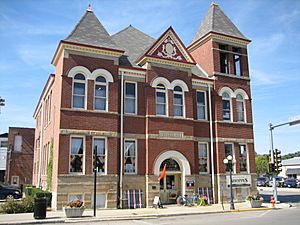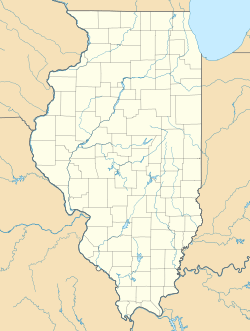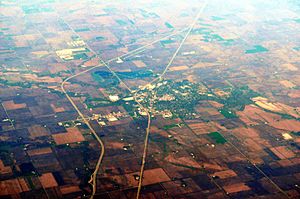Pontiac, Illinois facts for kids
Quick facts for kids
Pontiac, Illinois
|
|
|---|---|

Pontiac City Hall and Fire Station
|
|

Location of Pontiac in Livingston County, Illinois.
|
|
| Country | United States |
| State | Illinois |
| County | Livingston |
| Area | |
| • Total | 8.65 sq mi (22.40 km2) |
| • Land | 8.40 sq mi (21.75 km2) |
| • Water | 0.25 sq mi (0.65 km2) |
| Elevation | 640 ft (200 m) |
| Population
(2020)
|
|
| • Total | 11,150 |
| • Density | 1,327.70/sq mi (512.65/km2) |
| Time zone | UTC−6 (CST) |
| • Summer (DST) | UTC−5 (CDT) |
| ZIP Code(s) |
61764
|
| Area code(s) | 815 |
| FIPS code | 17-61015 |
| GNIS feature ID | 2396250 |
| Wikimedia Commons | Pontiac, Illinois |
| Website | City website |
Pontiac is a friendly city located in Livingston County, Illinois, in the United States. It's the main city, or county seat, of the county. In 2020, about 11,150 people called Pontiac home. Did you know the 1984 movie Grandview, U.S.A. was even set here?
Contents
Geography and Climate
Where is Pontiac Located?
Pontiac covers about 8.65 square miles (22.40 km2) of land. Most of the area around the city is farmland.
The city is built along the Vermilion River. This river has caused some big floods in Pontiac's history. The worst flood happened in December 1982. Another major flood occurred in January 2008.
What is Pontiac's Climate Like?
Pontiac experiences a climate with four distinct seasons. Summers are usually warm, while winters can be quite cold. The city gets a good amount of rain and some snow each year.
| Climate data for Pontiac, Illinois (1991–2020 normals, extremes 1903–2017) | |||||||||||||
|---|---|---|---|---|---|---|---|---|---|---|---|---|---|
| Month | Jan | Feb | Mar | Apr | May | Jun | Jul | Aug | Sep | Oct | Nov | Dec | Year |
| Record high °F (°C) | 69 (21) |
73 (23) |
86 (30) |
96 (36) |
102 (39) |
105 (41) |
108 (42) |
104 (40) |
103 (39) |
94 (34) |
82 (28) |
71 (22) |
108 (42) |
| Mean maximum °F (°C) | 52.6 (11.4) |
58.2 (14.6) |
73.5 (23.1) |
83.3 (28.5) |
87.9 (31.1) |
92.8 (33.8) |
94.2 (34.6) |
93.0 (33.9) |
89.8 (32.1) |
82.8 (28.2) |
70.5 (21.4) |
56.5 (13.6) |
96.2 (35.7) |
| Mean daily maximum °F (°C) | 32.4 (0.2) |
37.0 (2.8) |
49.3 (9.6) |
62.8 (17.1) |
73.6 (23.1) |
82.0 (27.8) |
84.3 (29.1) |
83.0 (28.3) |
78.1 (25.6) |
65.3 (18.5) |
50.2 (10.1) |
37.8 (3.2) |
61.3 (16.3) |
| Daily mean °F (°C) | 24.8 (−4.0) |
28.8 (−1.8) |
39.6 (4.2) |
51.7 (10.9) |
62.8 (17.1) |
72.0 (22.2) |
75.0 (23.9) |
73.3 (22.9) |
66.9 (19.4) |
54.6 (12.6) |
41.3 (5.2) |
30.3 (−0.9) |
51.8 (11.0) |
| Mean daily minimum °F (°C) | 17.2 (−8.2) |
20.5 (−6.4) |
30.0 (−1.1) |
40.6 (4.8) |
52.1 (11.2) |
62.1 (16.7) |
65.7 (18.7) |
63.6 (17.6) |
55.7 (13.2) |
43.8 (6.6) |
32.5 (0.3) |
22.7 (−5.2) |
42.2 (5.7) |
| Mean minimum °F (°C) | −5.9 (−21.1) |
0.2 (−17.7) |
12.4 (−10.9) |
25.1 (−3.8) |
36.6 (2.6) |
47.9 (8.8) |
53.8 (12.1) |
52.2 (11.2) |
39.7 (4.3) |
28.6 (−1.9) |
17.5 (−8.1) |
−0.5 (−18.1) |
−11.1 (−23.9) |
| Record low °F (°C) | −24 (−31) |
−23 (−31) |
−14 (−26) |
11 (−12) |
24 (−4) |
38 (3) |
42 (6) |
40 (4) |
26 (−3) |
9 (−13) |
−5 (−21) |
−23 (−31) |
−24 (−31) |
| Average precipitation inches (mm) | 1.99 (51) |
1.76 (45) |
2.62 (67) |
3.49 (89) |
4.43 (113) |
3.90 (99) |
3.71 (94) |
3.73 (95) |
3.39 (86) |
3.24 (82) |
2.56 (65) |
2.13 (54) |
36.95 (939) |
| Average snowfall inches (cm) | 6.7 (17) |
8.0 (20) |
3.4 (8.6) |
0.6 (1.5) |
0.0 (0.0) |
0.0 (0.0) |
0.0 (0.0) |
0.0 (0.0) |
0.0 (0.0) |
0.0 (0.0) |
0.7 (1.8) |
5.7 (14) |
25.1 (64) |
| Average precipitation days | 9.1 | 7.9 | 9.6 | 10.9 | 11.9 | 10.1 | 8.9 | 8.7 | 7.6 | 8.4 | 9.1 | 9.3 | 111.5 |
| Average snowy days | 4.6 | 4.0 | 1.7 | 0.2 | 0.0 | 0.0 | 0.0 | 0.0 | 0.0 | 0.0 | 0.7 | 3.2 | 14.4 |
| Source: NOAA (mean maxima/minima 1981–2010) | |||||||||||||
History of Pontiac
Early Days and Founding
Pontiac was officially started on July 27, 1837. Henry Weed and the Young brothers, Lucius and Seth, planned the town. They wanted to create a main city for the new Livingston County.
The founders promised to donate land for a courthouse and jail. They also agreed to build a bridge over the Vermilion River. However, the Young brothers died soon after, and Henry Weed moved away. So, the people who started Pontiac weren't the ones who developed it.
How Pontiac Was Designed
The original town plan was typical for Midwestern towns back then. It was built around a town square. This square was the center of town and where important buildings like the courthouse would be.
The town was quite large for its time. It had 93 blocks, with many lots for homes and businesses. The new town stretched across both sides of the river.
Naming the Town and Early Challenges
Jesse W. Fell, an Illinois legislator, chose the name "Pontiac." He named it after a famous Native American leader, even though the leader had never been to this area. Fell also named Livingston County.
Early growth was very slow. Some people wanted to move the county seat away from Pontiac. They said the founders hadn't kept their promises. They also claimed Pontiac was too low and unhealthy. In 1839, there was a vote to move the county seat. Pontiac won by a small margin, so it remained the county's main city.
After some delays, the first wooden courthouse was finished in 1847. A bridge was also built across the Vermilion River. But soon after it opened, a flood washed the bridge away!
Challenges and Growth in the Mid-1800s
In the early 1840s, Pontiac was still very small. It had only a few cabins and an unfinished courthouse. In 1848, August Fellows opened a hotel, which also hosted some of the first church services.
In 1849, a disease called cholera spread through Pontiac, sadly killing August Fellows and two of his children. His wife, Maria Tracey Fellows, continued to run the hotel.
In 1851, there was another attempt to move the county seat. A new town called Richmond was planned nearby. Its supporters thought a new railroad would go through Richmond, not Pontiac. However, Jesse W. Fell, who still cared about Pontiac, had friends in the railroad company. The railroad tracks ended up going through Pontiac instead! Richmond was soon abandoned, and some of its buildings were even moved to Pontiac.
On July 4, 1854, the first train arrived in Pontiac. Regular train service on the Chicago and Alton Railroad began a few months later. This was a huge step for the town!
Years of Fast Growth
With the railroad, Pontiac quickly became a busy place. More people moved in, and money became available for improvements. In 1856, Pontiac officially became an incorporated city.
In 1870, the state opened the Reform School in Pontiac. This was meant to be a modern correctional facility for boys. Jesse W. Fell donated land for it. Today, this facility is known as the Pontiac Correctional Center.
A big fire in 1870 destroyed many buildings in downtown Pontiac. After the fire, the city decided that new buildings in the downtown area had to be made of brick. This helped prevent future fires and gave Pontiac its unique look.
In 1871, another railroad, the Chicago and Paducah Railroad, was built. This brought even more trade to the city. A second, larger courthouse was also built. But on July 4, 1874, fireworks accidentally started a fire that burned down the courthouse.
The county decided to build an even grander courthouse. They hired a famous architect named John C. Cochrane. The beautiful new courthouse was finished in 1875. It was later added to the National Register of Historic Places in 1986.
Continued Development and Famous Visitors
Improvements continued rapidly in Pontiac. In 1882, the city got its first electric lights. In 1891, a strong iron bridge replaced the old wooden one over the Vermilion River. Pontiac also built its own water system in 1892. Many new buildings were constructed around the courthouse square between 1875 and 1900.
Many famous people visited Pontiac. Abraham Lincoln came to town several times in the 1840s and 1850s. He even gave a speech here in 1860. Other important figures like Stephen A. Douglas, Owen Lovejoy, Ulysses S. Grant, and William Jennings Bryan also visited. In 1903, President Theodore Roosevelt spoke in Pontiac and unveiled a soldier's monument.
The Automobile Age
New highways often follow old railroad routes. This happened in Pontiac too. In 1922 and 1923, Route 4, the first paved highway between Chicago and St. Louis, was built. It followed the same path as the first railroad. This new road brought more traffic through the center of Pontiac.
In 1925, the old iron bridge over the Vermilion River was replaced with a new steel and concrete one to handle the increased traffic. Also in 1925, Route 4 was renamed Route 66. This famous highway simply used the existing pavement of Route 4.
The Threshermen's Reunion started in Pontiac in 1949. It began as a small gathering of people who loved old farm machinery. It grew very popular, and now they have their own large area north of town.
In the 1960s and 1970s, Interstate 55 was built. It followed Route 66 closely. This new highway led to many businesses opening near the exits in Pontiac. Pontiac is still served by train passenger service today, with Amtrak trains stopping here on their way between Chicago and St. Louis.
Pontiac is also home to the Illinois Route 66 Hall of Fame. It used to be in McLean, Illinois, but it moved to a bigger location in Pontiac.
Population and Demographics
| Historical population | |||
|---|---|---|---|
| Census | Pop. | %± | |
| 1860 | 733 | — | |
| 1870 | 1,657 | 126.1% | |
| 1880 | 2,242 | 35.3% | |
| 1890 | 2,784 | 24.2% | |
| 1900 | 4,266 | 53.2% | |
| 1910 | 6,090 | 42.8% | |
| 1920 | 6,664 | 9.4% | |
| 1930 | 8,272 | 24.1% | |
| 1940 | 7,109 | −14.1% | |
| 1950 | 7,562 | 6.4% | |
| 1960 | 8,435 | 11.5% | |
| 1970 | 10,595 | 25.6% | |
| 1980 | 11,227 | 6.0% | |
| 1990 | 11,428 | 1.8% | |
| 2000 | 11,864 | 3.8% | |
| 2010 | 11,931 | 0.6% | |
| 2020 | 11,150 | −6.5% | |
| U.S. Decennial Census | |||
In 2000, Pontiac had 11,864 residents living in 4,139 households. About 31.9% of these households had children under 18. The average household had 2.39 people.
The population was spread out in terms of age. About 22.9% were under 18, and 13.5% were 65 or older. The average age in the city was 35 years old.
Media and Education
Local News and Radio
Pontiac has its own newspaper called The Daily Leader. You can also listen to local radio stations like WIBL 107.7 ("The Bull") and WJEZ 98.9.
Schools in Pontiac
Younger students in Pontiac attend public elementary and junior high schools run by Pontiac Elementary School District 429. For high school, students go to Pontiac Township High School, which is part of District #90.
Fun Things to Do in Pontiac
Museums to Explore
Pontiac is home to several interesting museums:
- The Route 66 Hall of Fame and Museum
- The Pontiac Oakland Museum
- The Livingston County War Museum
- The Yost House Museum and Art Center
- The International Walldog Mural and Sign Art Museum
Amazing Murals
Downtown Pontiac is famous for its collection of more than 20 murals. These large paintings show important events, people, and places from the town's history. One popular mural is a huge Route 66 shield, which is a favorite spot for tourists to take photos!
Parks and Recreation
Pontiac has 10 public parks that are open from dawn to dusk. They offer many ways to have fun:
- *Jaycee Park:* A 4.6-acre park with a baseball field and playground.
- *Play Park:* A 12.5-acre park with a boat ramp, disc golf, and two swinging bridges.
- *Dargan Park:* A 2-acre park with sculptures, a picnic area, and playground.
- *Chautauqua Park:* A large 26.5-acre park with an auditorium, picnic areas, disc golf, and a swinging bridge.
- *Humiston-Riverside Park:* A 5-acre park with playground equipment and a swinging bridge.
- *Westview Park:* A 5.2-acre park with a picnic pavilion, basketball court, and playground.
- *Fell Park:* A 2.3-acre park with a basketball court, skate park, and playground.
- *Kiwanis-Humiston Park:* A 1.7-acre park with five pickleball courts, a tennis court, and a softball/baseball field.
- *Lions Park:* A 1.3-acre park with a basketball court, softball/baseball field, and playground.
- *Recreation Complex:* A huge 60-acre park with five softball/baseball fields, a football field, basketball courts, tennis courts, sand volleyball pits, a dog park, and playground equipment.
Notable People from Pontiac
Many interesting people have connections to Pontiac:
- Donald Attig: A businessman, inventor, and adventurer.
- Harry Bay: A professional baseball outfielder.
- E. Wayne Craven: A well-known art historian.
- Emily Grove: A talented pole vaulter.
- Moira Harris: An actress married to Gary Sinise.
- William C. Harris: An Illinois state legislator.
- Irene Hunt: A Newbery Medal winning author.
- Frank L. Pinckney: A former head coach for Illinois Fighting Illini men's basketball.
- Dan Rutherford: A former Illinois Treasurer.
- Mark Schwahn: A screenwriter, director, and producer.
- Patricia Tallman: An actress and stuntwoman.
- Natashia Williams: An actress.
Transportation
- Pontiac, Illinois (Amtrak station): You can catch an Amtrak train here.
- Pontiac Municipal Airport (KPNT): This airport is located 3 miles north of the town.
Images for kids
See also
 In Spanish: Pontiac (Illinois) para niños
In Spanish: Pontiac (Illinois) para niños





